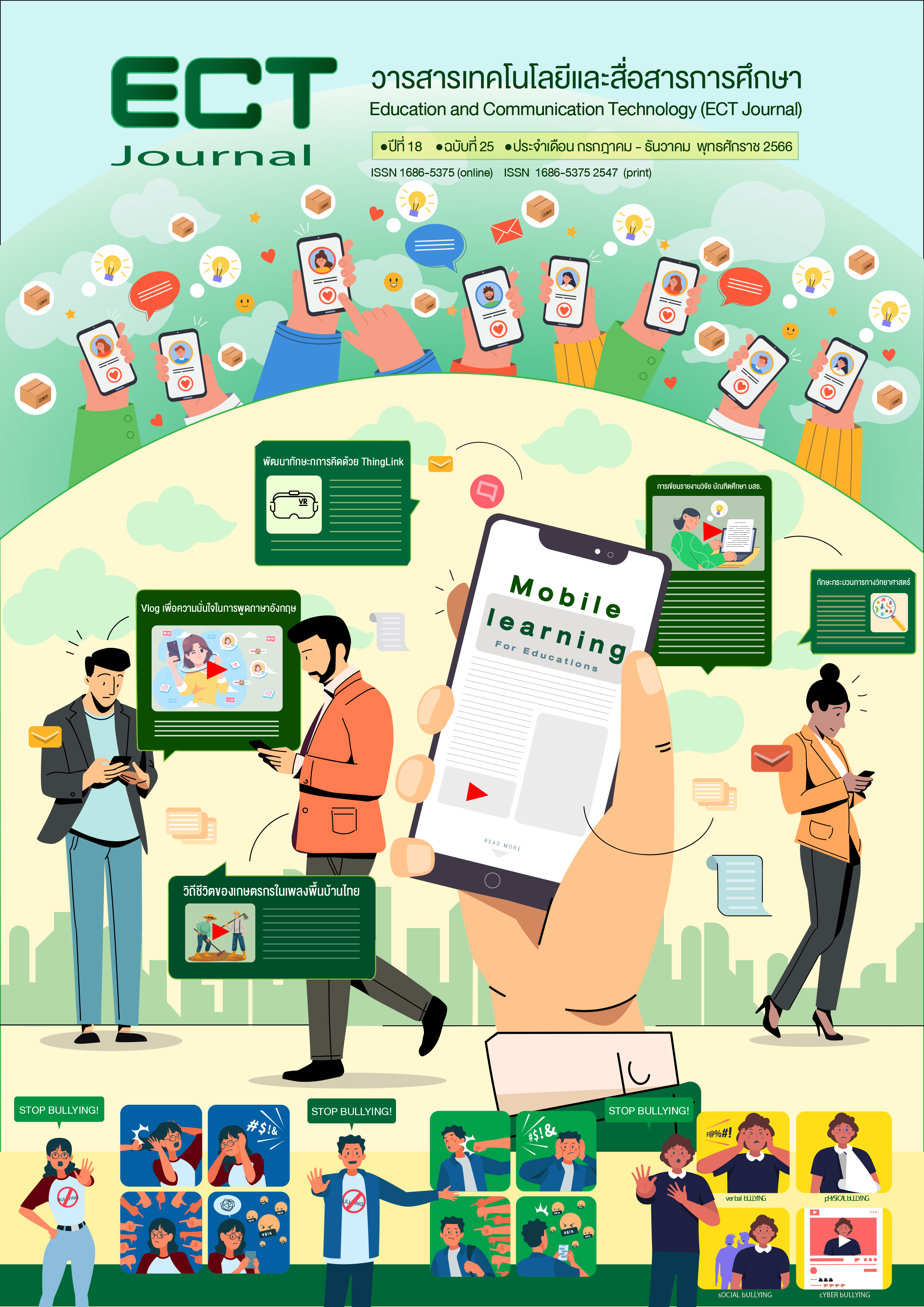Effect of Development of Design-based Learning Model via Social Media to Enhance High School Students’ Creative Product
Keywords:
Design-based Learning, Social Media, Creative productAbstract
This study aims to investigate the effect on development of Design-Based Learning Model via Social Media to enhance high school students’ creative product. The sample for this investigation, which was carried out over a period of 12 weeks, consisted of 45 ninth-grade students from Samsenwithayalai School. The research tool is a lesson plan based on design-based learning model via social media to enhance high school students’ creative product, social media and model. The research data were collected using creative product assessment, the model learning process assessment and student satisfaction survey which were analyzed using mean, standard deviation (SD), and One-Way ANOVA with Repeated Measure Analysis. The results showed that after three sessions of the investigation, the scores of the creative products in the first, second, and third session scores were significantly different at the .05 level. The third session score for the creative product was higher than the second session score for the creative product. And the second session score was higher than the first session score for the creative product
References
ประจักษ์ ปฏิทัศน์. (2562). การคิดเชิงระบบและความคิดสร้างสรรค์. ศูนย์หนังสือแห่งจุฬาลงกรณ์มหาวิทยาลัย.
รัตตมา รัตนวงศา. (2559). การพัฒนารูปแบบการเรียนการสอนในสภาพแวดล้อมแบบเกมมิฟิเคชันโดยใช้การออกแบบเป็นฐานร่วมกับเครื่องมือทางทัศนะเพื่อส่งเสริมการรู้ทางทัศนะและแรงจูงใจใฝ่สัมฤทธิ์สำหรับนิสิตนักศึกษาระดับปริญญาบัณฑิต [วิทยานิพนธ์ปริญญาดุษฎีบัณฑิต ไม่ได้ตีพิมพ์]. จุฬาลงกรณ์มหาวิทยาลัย.
สถาบันส่งเสริมการสอนวิทยาศาสตร์และเทคโนโลยี. (2563). เกณฑ์การประเมินความคิดสร้างสรรค์ หนังสือเรียนคู่มือครูรายวิชาพื้นฐานวิทยาศาสตร์และเทคโนโลยี. สกสค.
สำนักงานคณะกรรมการข้าราชการพลเรือน. (2559). การคิดเชิงสร้างสรรค์. https://www.ocsc.go.th/download/2560/การคิดเชิงสร้างสรรค์-ebook
Geitz, G., & de Geus, J. (2019). Design-based education, sustainable teaching, and learning. Cogent Education, 6(1), 1-15. https://doi.org/10.1080/2331186X.2019.1647919
Gómez Puente, S. M., Van Eijck, M., & Jochems, W. (2013). A sampled literature review of design-based learning approaches: A search for key characteristics. International Journal of Technology and Design Education, 23(3), 717-732. https://doi.org/10.1007/s10798-012-9212-x
Henriikka, V., Anu, L., & Jorma, E. (2012). Design-oriented pedagogy for technology-enhanced learning to cross over the borders between formal and informal environments. Journal of Universal Computer Science, 18(15), 2097-2119. https://www.researchgate.net/publication/280016412
Kharis, Dameria, & Ebner. (2020). Perception and acceptance of Padlet as a microblogging platform for writing skills. ResearchGate. https://www.researchgate.net/publication/343661829
Lee, H. K., & Breitenberg, M. (2010). Education in the new millennium: The case for design-based learning. International Journal of Art and Design Education, 29(1), 54-60. https://doi.org/10.1111/j.1476-8070.2010.01631
Ratcheva, V. S., & Leopold, T. (2018). 5 things to know about the future of jobs. World Economic Forum. https://www.weforum.org/agenda/2018/09/future-of-jobs-2018-things-to-know
Rathakrishnan, M., Ahmad, R., & Suan, C. L. (2017). Online discussion: Enhancing students' critical thinking. International Journal of Social Sciences, 3(2), 2455-2569. https://doi.org/10.1063/1.5005453
Downloads
Published
How to Cite
Issue
Section
License
Copyright (c) 2023 มหาวิทยาลัยสุโขทัยธรรมาธิราช

This work is licensed under a Creative Commons Attribution-NonCommercial-NoDerivatives 4.0 International License.
1. ทรรศนะและข้อคิดเห็นใด ๆ ที่ปรากฏอยู่ในวารสาร ECT Education and Communication Technology Journal เป็นของผู้เขียนโดยเฉพาะ สำนักเทคโนโลยีการศึกษา มหาวิทยาลัยสุโขทัยธรรมาธิราช และกองบรรณาธิการไม่จำเป็นต้องเห็นพ้องด้วย
2. กองบรรณาธิการของสงวนลิขสิทธิ์ในการบรรณาธิการข้อเขียนทุกชิ้น เพื่อความเหมาะสมในการจัดพิมพ์เผยแพร่






